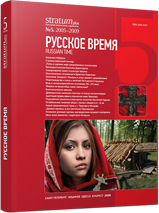Адаптация православия в языческом мире Прикамья
Adoption of Christianity in paganish society of Kama Region
Author(s): Leonid D. MakarovSubject(s): History, Archaeology, Cultural history, Middle Ages, Modern Age, 6th to 12th Centuries, 13th to 14th Centuries, 15th Century, 16th Century, 17th Century, 18th Century, 19th Century, Sociology of Religion, History of Religion
Published by: Издательский дом Stratum, Университет «Высшая антропологическая школа»
Keywords: Christianity; Paganish Society; Kama Region
Summary/Abstract: Old Russian settlers brought new ideology on the territory of the Kama River Region – Slavic and Finnish paganism and Greek Christianity, as it is usually said about the finds of religious pendants, signs of temples, peculiarities of burials. Inculcation of Christianity had taken place during 3 main periods.First period (10th – 13th centuries) is acquaintance (passive). In many respects it is characterized by accidental and elementary emergence of Christian attributes in the Kama Region. A part of these things were found in composition of necklaces in Finn-Perm burial places, possibly playing role of pendants, which were endowed with some sacred functions. Other things were worn with other pendants, but were considered Christian. They were found with their bearers.Second period (13th – 16th centuries) is an active stage. It coincides with Old Russian population of Kama basin and bringing real Christianity among the local population, but with preservation of religious syncretism. It is characterized by decoration of Christian advents on territory of Volga’s Bulgaria, Vyatka territory and the Great Perm. It is connected to a marked degree with missionary activity of first priests of this land including Stephan of Perm and Trifon Vyatskiy. This period is documented by findings of numerous Christian worship items. Christian funeral ceremony, which preserved separate pagan relicts, was confirmed.Third period (17th – 19th centuries) is state one (massive). It is conditioned by processes of inner colonization of the Kama Region. This period was accompanied by different forms of Christianization of indigenous pagan inhabitants assisted by the state. It is characterized by active construction of churches and cloisters, inculcation of Christian morale, spirituality and culture in non-Russian society. Ritualism of Christian advents finally fixed and unified in this period. It was reflected also in archeological sources. Archaic elements remained in old-ceremony society. These elements also had influence on foreign material and spiritual culture.
Journal: Stratum plus. Археология и культурная антропология
- Issue Year: 2009
- Issue No: 5
- Page Range: 414-419
- Page Count: 6
- Language: Russian
- Content File-PDF

